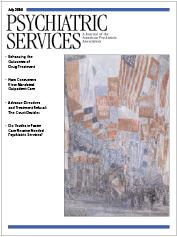Stigma and Public Education About Mental Illness
To the Editor: Thank you for publishing the report by Patrick Corrigan and his colleagues (1) in the May 2004 issue describing how people's attitudes are affected when they are exposed to a mental illness education program that emphasizes violence. At last, advocates can cite research to support a common wisdom that fear fuels prejudice and excessive control.
Although the report refers to "community groups" that emphasize violence to win support, the chief strategists who made public safety the key to new state laws are at the Treatment Advocacy Center in Arlington, Virginia, a creation of psychiatrist E. Fuller Torrey. More than a decade ago, Dr. Torrey and D. J. Jaffe, a Manhattan advertising executive, began to advocate for their legislative agenda by playing on the public's fear of violence and suggesting that others do the same.
Dr. Corrigan's study shows us some possible results of framing mental illnesses as a threat to public safety. His research team tested 161 participants assigned randomly to two types of public education, one linking mental illnesses to violence and the other providing antistigma information. A third group served as a control group. The results showed that participants in the program that highlighted violence favored coercion and separation of people with mental illnesses and avoidance of them. Participants in the program that highlighted antistigma information responded with less fear and more positive attitudes. In a noteworthy finding, the participants in general contradicted a belief that public fears drive funding. In fact, none of the three groups showed significant interest in mandating resources to improve the lives of people with mental illnesses.
Regrettably, Dr. Corrigan's report presented as factual Dr. Torrey's claim that 1,000 homicides are committed annually by people with mental illnesses. That is not a fact. My colleagues and I have seen this number used often, always in Dr. Torrey's articles and media appearances that focus on violence. The figure is meaningless without more details, such as comparisons with the rate in the U.S. general population and the rate among other subgroups. Therefore, we can only assume that the purpose of this figure is to scare clueless audiences. Readers of Psychiatric Services may know that the figure is unscientific, but the public does not. It is painful to see new credibility bestowed on it.
Ms. Arnold is chair and cofounder of the National Stigma Clearinghouse in New York City.
1. Corrigan PW, Watson AC, Warpinski AC, et al: Implications of educating the public on mental illness, violence, and stigma. Psychiatric Services 55:577–580, 2004Link, Google Scholar



